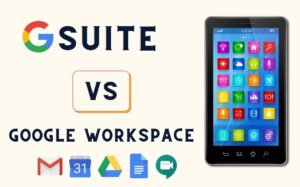Google Workspace For Non-Technical Teams: Tips For Success
Google Workspace has revolutionized the way teams collaborate and communicate. With its powerful suite of tools, it offers a seamless experience for individuals and teams to work together on projects, documents, and presentations.
However, for non-technical teams who are new to using Google Workspace, it can be overwhelming and confusing. This guide is aimed at non-technical teams who want to use Google Workspace effectively.
It will provide tips on how to navigate the platform, use its features efficiently, and communicate with team members seamlessly. Whether you’re a small business owner or part of a larger organization, this guide will help you harness the full potential of Google Workspace.
Customizing Google Workspace to meet your team’s unique needs can help streamline workflows and increase productivity. Customize the Dashboard: The dashboard is the first thing your team sees when logging into Google Workspace.
Customize it to display the most frequently used apps, tools, and files. Create Shared Templates: Create templates for commonly used documents like presentations, reports, or project plans that can be accessed by everyone in your team.
Use Add-ons: Add-ons are third-party tools that integrate with Google Workspace to provide additional features and functionality. Set Up Custom Labels and Filters: Use labels and filters to categorize emails, documents, and other files in a way that makes sense for your team.
Use Google Meet for virtual meetings and video conferencing, with the option to record meetings for future reference. Create shared folders in Google Drive to organize files and documents, making it easy for team members to access and collaborate on the same files.
Utilize Google Docs, Sheets, and Slides for real-time collaboration on documents, spreadsheets, and presentations. Use Google Forms for surveys or feedback collection from team members or customers.
Set up a shared calendar in Google Calendar to schedule meetings and deadlines efficiently.
Encourage team members to use Google Chat as an instant messaging platform within the organization.
Effective project management is key to the success of any team, and Google Workspace offers a range of features to support this. Use Google Drive to store all project-related files in one place and ensure easy access for everyone on the team.
Set up shared calendars in Google Calendar to keep track of deadlines, meetings, and other important dates. Create project-specific mailing lists in Gmail to ensure that everyone stays informed about updates and progress.
Use Google Docs, Sheets, and Slides for collaborative editing and real-time feedback on all aspects of the project. Encourage team members to use Google Meet for video conferencing and screen sharing when working remotely or from different locations.
Familiarize yourself with the tools: Take the time to explore and understand the various applications and features within Google Workspace. This includes tools like Gmail, Google Drive, Google Docs, Google Sheets, Google Slides, and Google Meet.
Customize your workspace: Tailor Google Workspace to suit your team’s specific needs. Customize settings, organize folders, and set up notifications to optimize your workflow and ensure easy access to relevant files and information.
Foster collaboration: Encourage team members to collaborate on documents in real-time using tools like Google Docs and Google Sheets. Leverage the commenting and suggestion features to provide feedback and streamline the review process.
Utilize shared calendars: Coordinate schedules and plan meetings effectively using shared calendars in Google Workspace. This allows team members to stay informed about upcoming events, deadlines, and team availability.
Optimize communication: Take advantage of communication tools like Google Meet and Google Chat to facilitate virtual meetings, instant messaging, and video conferences. Encourage open and transparent communication within the team.
Enable mobile access: Install the Google Workspace mobile apps on your devices to stay connected and access important files, emails, and documents on the go. This ensures that team members can work remotely or while traveling.
Provide training and support: Offer training sessions or resources to help team members become familiar with Google Workspace. Provide ongoing support and encourage continuous learning to maximize the benefits of the tools.
Ensure data security: Familiarize yourself with the security features offered by Google Workspace and implement best practices to protect sensitive data. This includes enabling two-factor authentication, setting strong passwords, and regularly reviewing access permissions.
Collaborate with external parties: Use Google Workspace’s sharing capabilities to collaborate with external partners, clients, or vendors. Grant appropriate access levels to ensure secure collaboration while maintaining control over your data.
Stay updated with new features: Google Workspace regularly introduces new features and updates. Stay informed about these updates to leverage new functionalities that can further enhance your team’s productivity and collaboration.
Why To Use Google Workspace For Non-Technical Teams
Google Workspace is a powerful tool for non-technical teams looking to streamline their communication and collaboration efforts. With features such as Gmail, Google Calendar, and Google Drive, team members can easily communicate with each other, schedule meetings and share files in one central location.
Additionally, tools like Google Docs and Sheets allow team members to collaborate on projects in real-time, making it easier to work together towards common goals.
By using Google Workspace, non-technical teams can save time and increase productivity by reducing the need for multiple platforms or tools to manage their workflow.
Google Workspace offers a user-friendly interface that is easy to navigate, making it an ideal productivity tool for non-technical teams. With its intuitive design and familiar features, such as Gmail, Google Drive, and Google Calendar, users can easily collaborate and communicate with each other in real-time.
Additionally, the platform’s cloud-based storage enables team members to access files from anywhere with an internet connection, eliminating the need for cumbersome file-sharing systems.
By streamlining workflows and reducing time spent on administrative tasks, Google Workspace empowers non-technical teams to focus on their core responsibilities and increase overall productivity and efficiency.
Google Workspace offers a variety of tools that can help elevate teamwork and project management for non-technical teams. One of the most useful features is the ability to create shared calendars and documents. With shared calendars, team members can easily keep track of deadlines, meetings, and events.
They can also see when their colleagues are available for collaboration or discussion. Shared documents allow team members to collaborate in real-time on projects, making it easier to stay organized and on-task.
These features are particularly helpful for non-technical teams who may not have a dedicated project manager or technical support staff to keep things running smoothly.
One of the key benefits of using Google Workspace for non-technical teams is the built-in safeguards that enhance security and data protection. With Workspace, businesses can protect their sensitive information with features such as two-factor authentication, single sign-on, and encryption.
Workspace also provides advanced phishing protection, which helps to prevent cyber attacks that could compromise company data. Additionally, Workspace offers granular controls over user access and sharing permissions to ensure data is only accessible by authorized individuals.
By utilizing these powerful security features, businesses can safeguard their valuable assets and maintain the trust of their customers and partners.
Google Workspace offers a range of cloud-based solutions that can help non-technical teams simplify their workflows and reduce IT costs. With Google Drive, users can store and share files securely in the cloud, eliminating the need for on-premise servers.
Google Docs, Sheets, and Slides provide collaborative tools for team members to create and edit documents together in real-time, from anywhere. Gmail allows users to access email from any device with an internet connection.
Additionally, Google Workspace’s admin console makes it easy for non-technical staff to manage user accounts and settings without requiring specialized IT knowledge or expertise.
Advantages Of Using Google Workspace For Non-Technical Teams
Google Workspace is a cloud-based productivity suite designed to help teams collaborate and communicate effectively. Formerly known as G Suite, it offers a wide range of tools and applications that can be accessed from anywhere with an internet connection.
With its user-friendly interface, Google Workspace simplifies team collaboration by allowing team members to work together on projects in real-time. It also provides seamless integration with other Google products such as Gmail, Google Drive, and Google Meet.
In this article, we will explore the advantages of using Google Workspace for non-technical teams and how it can enhance productivity and streamline workflows.
Google Workspace offers a range of tools that make collaboration among non-technical teams simpler and more efficient. With Google Drive, team members can easily share files and folders, making it easier to work on projects together.
The cloud-based nature of Google Workspace means that team members can access and edit documents from anywhere with an internet connection. Communication is streamlined with tools like Gmail and Google Meet, allowing teams to easily connect and discuss projects in real-time.
Additionally, the ability to assign tasks using Google Tasks helps teams stay organized and on track towards meeting their goals.
Enhanced productivity with Google Workspace is one of the significant benefits that non-technical teams can enjoy.
The integrated suite of tools, such as Gmail, Drive, Docs, Sheets, and Slides, allows team members to collaborate seamlessly on projects in real-time. With features like commenting and suggesting edits in documents, team members can communicate and work together more efficiently.
Additionally, Google Workspace offers smart suggestions for email responses and appointments through its AI-powered platform.
This streamlines communication within the team and saves time on administrative tasks.
Overall, Google Workspace improves workflow processes and enables non-technical teams to achieve their goals with ease while boosting productivity levels.
Secure data management with Google Workspace is a crucial advantage for non-technical teams. Google’s advanced security features provide a secure platform to store, share, and collaborate on sensitive information.
With features like two-step verification, data encryption, and access controls, users can ensure that their data is protected from unauthorized access or theft. Additionally, Google Workspace allows users to track the activity history of files and folders to monitor any changes made by team members.
This feature helps prevent accidental deletions or modifications that could lead to the loss of important information. Overall, secure data management with Google Workspace provides peace of mind for non-technical teams handling critical information.
Google Workspace offers a cost-effective solution for non-technical teams. It eliminates the need for expensive hardware, software licenses, and IT support, as all the necessary tools are available on the cloud.
This means that teams can collaborate seamlessly without worrying about maintenance costs or upgrades. Moreover, Google Workspace comes with a variety of plans to suit different budgets and needs, making it accessible to small businesses and startups.
With its simple user interface and intuitive design, non-technical teams can easily navigate the platform without requiring extensive training or technical knowledge.
Overall, Google Workspace is an affordable option that enables non-technical teams to work efficiently and effectively together.
In today’s fast-paced digital world, non-technical teams can benefit immensely from using Google Workspace. This suite of cloud-based productivity and collaboration tools, including Gmail, Google Drive, Google Docs, Google Sheets, Google Slides, and Google Meet, can significantly enhance the efficiency and productivity of any team. Here are some tips for non-technical teams to succeed with Google Workspace:
1. Embrace Collaboration
a. Real-Time Editing: Google Docs, Sheets, and Slides allow multiple team members to work on the same document simultaneously. This real-time editing feature helps teams to collaborate more effectively, avoid version control issues, and get immediate feedback.
b. Commenting and Suggestions: Use the commenting and suggesting features to provide feedback and suggestions without altering the original content. This functionality helps maintain clarity and transparency in the editing process.
2. Effective Communication
a. Gmail and Chat: Leverage Gmail for email communication and Google Chat for instant messaging. Organize your Gmail inbox with labels, filters, and priority inbox settings to keep track of important emails. Use Google Chat for quick, real-time communication with team members.
b. Google Meet: Schedule and conduct virtual meetings using Google Meet. Ensure meetings are productive by sharing agendas beforehand, using screen sharing, and recording meetings for those who cannot attend.
3. Organize and Manage Files
a. Google Drive: Store all your documents, presentations, spreadsheets, and other files in Google Drive. Use folders to organize files by project, department, or client. Set appropriate sharing permissions to control access and maintain security.
b. Version Control: Take advantage of Google Drive’s version history feature to track changes and revert to previous versions if needed. This ensures you never lose important data and can always refer back to earlier versions of documents.
4. Maximize Productivity
a. Task Management: Use Google Tasks to create to-do lists and manage tasks efficiently. Integrate Google Tasks with Gmail and Google Calendar to keep track of deadlines and prioritize tasks.
b. Calendar Management: Google Calendar is an excellent tool for scheduling meetings, setting reminders, and managing your time. Share your calendar with team members to coordinate schedules and avoid conflicts.
5. Utilize Add-Ons and Extensions
a. Google Workspace Marketplace: Explore the Google Workspace Marketplace for add-ons and extensions that can enhance the functionality of your Google Workspace apps. Tools like Trello, Asana, and Slack can integrate seamlessly with Google Workspace, offering additional productivity features.
b. Custom Scripts: For more advanced users, Google Apps Script can be used to automate repetitive tasks, create custom functions, and integrate Google Workspace apps with other services.
6. Training and Support
a. Google Workspace Training: Encourage team members to participate in Google Workspace training sessions. Google offers a variety of online resources, including tutorials, webinars, and certification programs, to help users get the most out of their tools.
Conclusion
In conclusion, the article “Google Workspace For Non-Technical Teams: Tips For Success” provides a comprehensive guide that offers invaluable insights and actionable strategies for non-technical teams seeking to optimize their productivity and collaboration through the utilization of Google Workspace. By emphasizing the significance of comprehending the extensive range of features and capabilities offered by Google Workspace, as well as tailoring them to align with the specific needs of non-technical teams, this article equips teams with the knowledge and tools necessary to enhance their workflows and communication channels.
The article underscores the importance of following the provided tips, which encompass leveraging the diverse array of Google Workspace tools including Google Drive, Google Docs, Google Sheets, and Google Meet. These tools serve as powerful aids in streamlining workflows, fostering effective collaboration, and augmenting communication efficiency within non-technical teams.
Additionally, the article sheds light on the criticality of training and ongoing support in ensuring team members possess the necessary proficiency to maximize the potential of Google Workspace. By investing in training initiatives and extending ongoing support, organizations can empower their teams to harness the full range of features and functionalities offered by Google Workspace, thereby facilitating seamless adoption and integration into their daily operations.
By implementing the suggested strategies and embracing the transformative power of Google Workspace, non-technical teams can conquer challenges, unlock new levels of efficiency, and achieve their goals with greater effectiveness. With optimized productivity, enhanced collaboration, and improved communication, non-technical teams can propel themselves towards success and remain competitive in an ever-evolving digital landscape.
Frequently Asked Questions
Training is crucial for non-technical teams to fully utilize the potential of Google Workspace. It ensures that team members are proficient in using the tools, understand best practices, and can leverage the features effectively. Ongoing support and training also enable teams to adapt to new updates and enhancements within Google Workspace.
Non-technical teams may face challenges during the adoption process, but by implementing the tips and strategies provided in the article, they can address these challenges effectively. This includes gradually introducing new features, providing resources and support, and fostering a culture of continuous learning and improvement.
Yes, Google Workspace offers tools like Google Meet for video meetings and Google Chat for instant messaging, which facilitate seamless communication and collaboration among team members. These tools help non-technical teams stay connected, exchange ideas, and work together efficiently.
Google Workspace provides a collaborative environment where team members can work on documents simultaneously, leave comments, and track changes. This fosters effective collaboration, encourages teamwork, and reduces the need for multiple versions of files.
Yes, Google Workspace prioritizes security and offers various measures to protect user data. It includes features such as data encryption, two-factor authentication, and robust privacy settings. Google has stringent security protocols in place to safeguard user information and ensure data integrity.




